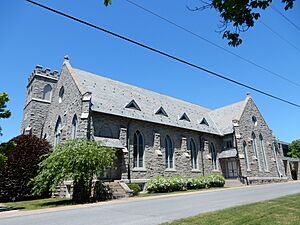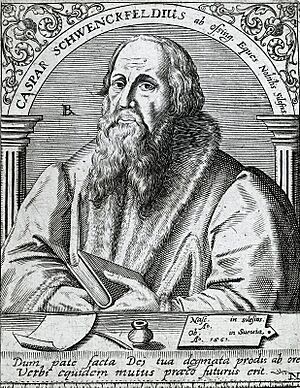Caspar Schwenckfeld facts for kids
Caspar Schwenkfeld von Ossig (born 1489 or 1490 – died December 10, 1561) was a German thinker, writer, and preacher. He was also a Protestant Reformer and a spiritual leader. He helped start the Protestant Reformation in a region called Silesia.
Schwenkfeld learned about the Reformation from other leaders like Thomas Müntzer and Andreas Karlstadt. But he soon developed his own ideas. He disagreed with Martin Luther about religious ceremonies, especially the Lord's Supper. Schwenkfeld believed in something called the "Heavenly Flesh doctrine." He worked on these ideas with his friend, Valentin Crautwald.
His followers became a new group, which was not allowed in Germany. Their ideas were similar to Anabaptism and Pietism. Many of his followers were treated badly in Europe. They had to either change their beliefs or leave. Because of this, some of their churches, called Schwenkfelder Church congregations, are now in the United States. This was once the Thirteen Colonies of British America.
Contents
Caspar Schwenkfeld's Early Life
Schwenkfeld was born in 1489 in Ossig, near Liegnitz, Silesia. This area is now Osiek, near Legnica, Poland. His parents were from a noble family. He studied in Cologne between 1505 and 1507. In 1507, he went to the University of Frankfurt on the Oder. From 1511 to 1523, Schwenkfeld worked as an adviser for the Duchy of Liegnitz. He advised Duke Charles I, Duke George I, and Duke Frederick II.
Caspar Schwenkfeld's Journey of Faith
Around 1518 or 1519, Schwenkfeld had a powerful spiritual experience. He called it a "visitation of God." The writings of Martin Luther greatly influenced him. Schwenkfeld accepted the Lutheran Reformation. He began to study the Bible deeply.
In 1521, Schwenkfeld started preaching the gospel. By 1522, he convinced Duke Friedrich II to become a Protestant. In 1523, he started a group for his new followers. They met to study and pray.
Disagreements with Luther
In 1525, Schwenkfeld disagreed with Luther's view of the real presence in the Lord's Supper. Schwenkfeld believed in a more spiritual meaning of the ceremony. Luther did not accept this idea. Schwenkfeld began to teach that true believers ate the spiritual body of Christ.
He wanted to see changes everywhere he went. But he also criticized other reformers if he thought they went too far. He believed that being a true Christian meant changing inside, not just outside. Because of his different views on communion and other topics, Schwenkfeld broke away from Luther. Scholars often see Schwenkfeld as part of the Radical Reformation. In 1529, he chose to leave Silesia. This was to protect his duke from problems. He lived in Strassburg from 1529 to 1534. After that, he lived in Swabia.
What Caspar Schwenkfeld Taught
Some of Schwenkfeld's main teachings included:
- Being against war, secret groups, and making oaths.
- Believing that the government should not control a person's beliefs.
- Teaching that spiritual change comes from God's grace working inside a person.
- Stressing that believers feed on Christ spiritually.
- Saying that true believers must show evidence of their inner change.
- He did not agree with infant baptism.
- He also rejected outward church forms and "denominations."
His ideas about the Eucharist made Luther write several sermons against him in 1526.
Caspar Schwenkfeld's Writings
In 1540, Luther forced Schwenkfeld to leave Silesia. In 1541, Schwenkfeld published a book called Great Confession on the Glory of Christ. Many people thought this writing was heretical. He taught that Christ had two natures, divine and human. He also believed Christ became more divine over time. During the 1550s, he wrote many works about understanding the Bible. He often replied to the arguments of the Lutheran reformer Matthias Flacius Illyricus.
Schwenkfeld also wrote Theriotropheum Silesiae. This book is thought to be the oldest published list of animals from a local area. It lists the animals of Silesia, including 150 kinds of birds.
Caspar Schwenkfeld's Death
In 1561, Schwenkfeld became ill with dysentery. He grew weaker and died in Ulm on the morning of December 10, 1561. Because he had many enemies, his death and burial place were kept secret.
The Schwenkfelder Church

Schwenkfeld did not create a separate church during his lifetime. But his followers gathered around his writings and sermons. By 1700, there were about 1,500 of them in Lower Silesia. Many had to leave Lower Silesia because the Austrian emperor treated them badly. Some found safety on the lands of Count Nicolaus Ludwig Zinzendorf. These followers became known as Schwenkfelders.
A group of Schwenkfelders arrived in Philadelphia in 1731. Five more groups followed them until 1737. In 1782, the Society of Schwenkfelders was formed. Later, in 1909, the Schwenkfelder Church was officially organized.
The Schwenkfelder Church is still small today. It has about 3,000 members and four churches. One of these is the Schwenkfelder Missionary Church in Philadelphia. All of its churches are within 50 miles (80 km) of Philadelphia.
Schwenkfelder Library & Heritage Center
The Schwenkfelder Library & Heritage Center is a small museum, library, and archive. It is located in Pennsburg, Pennsylvania. This center is the only place dedicated to keeping and sharing the history of the Schwenkfelders. This includes the life of Schwenckfeld, the Radical Reformation, and religious freedom. It also covers the history of Schwenkfelders in Europe and America, and the Schwenkfelder Church. The center holds exhibits and events throughout the year.


